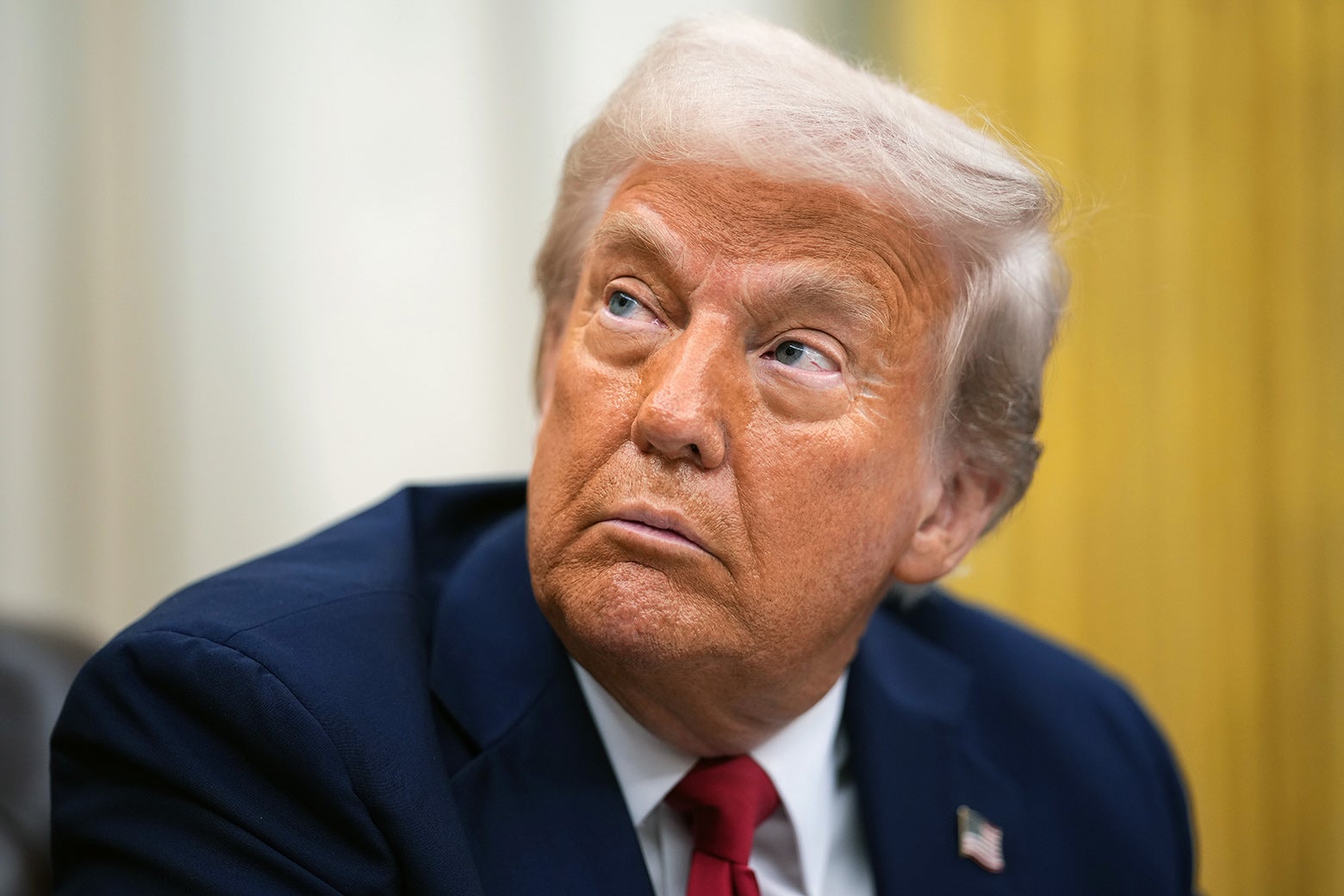Sign up for the Slatest to get the most insightful analysis, criticism, and advice out there, delivered to your inbox daily.
According to President Donald Trump, today is “Liberation Day,” folks! No, that does not mean we are being liberated from this reckless administration and its gangs of billionaire-hired goons. (That might happen later.) What it does mean is that a bunch more tariffs are about to go into effect—for real this time, they swear it. And these new taxes are gonna be yuge, much to everyone’s chagrin. Still, White House press secretary Karoline Leavitt continues to tout the new import taxes as a way of striking back at countries that take advantage of our free-trade generosity.
As ever, it was hard to tell what the specific courses of action would be in the lead-up to Wednesday’s Rose Garden announcement. Would there be “universal” tariffs, or would they be tailored to particular countries and industries? Will countries and companies actually start to Buy American, or will they be hostile in turn? Are we about to end up in a stagflationary recession? Can anyone stop this? Yeah. But will they? Nope.
We did get some clarity in a long, rambling press conference: The “reciprocal tariffs” will indeed be the approach. The president held up a chart to get across the point. The countries that charge high average tariffs on U.S.-made goods will be countered by American tariff rates that equate to about half of what they charge us. So because China reportedly fines key U.S. goods with both monetary and nonmonetary barriers at a 67 percent rate, the U.S. will counter with 34 percent charges. The European Union charges up to 40 percent, so we’re going to charge 20 percent. And on and on with so many of our major trading partners and allies. (The numbers assigned to other countries were calculated through absolutely nonsensical methods, as economics writer James Surowiecki has pointed out.)
There will, however, be a “baseline” rate of 10 percent to apply universally no matter the country of origin. So in the cases of the United Kingdom, Chile, and Brazil, their 10 percent rates will be countered by our 10 percent.
But what does all of it really mean for you? Allow us to cut through the noise and confusion and offer you yet another comprehensive guide to this newest bout of tariffs.
What are these new tariffs, exactly?
Treasury Secretary Scott Bessent told lawmakers on Tuesday that the rates would act as a “ceiling” that could be negotiated down, per CNN, provided that our trading partners respond in ways that please the U.S. president. So there’s room for all those rates to go down based on future negotiations, although it seems 10 percent will remain the “permanent” minimum.
We still could get more country- and sector-specific tariffs down the line: Discussions have revolved around extra surcharges on copper, pharmaceuticals, and lumber. (For now, those are excluded from the reciprocal tariffs, along with semiconductors.) Per Reuters, Big Pharma has lobbied Trump for “phase-in tariffs on imported pharmaceutical products in hopes of reducing the sting from the charges and to allow time to shift manufacturing.”
Wait, but what about the tariffs that were already planned or placed? Will those be changed at all?
The 25 percent tariffs on all steel and aluminum imports are still in effect, with a revision announced Wednesday—and set to take effect Friday—that will extend those taxes to derivative aluminum products like beer brands and empty cans.
There were also the broad-based tariffs on Canada and Mexico that were announced, delayed, delayed again, and then reimposed in early March, with exemptions determined by the U.S.–Mexico–Canada Trade Agreement (the NAFTA renegotiation that, I cannot stress enough, was approved by Trump during his first term). Those exemptions are still in place for goods deemed “compliant” with the agreement.
Last month, Trump also threatened a 25 percent “secondary tariff” on any country that buys crude oil from Venezuela, giving them an April 3 deadline to halt such trade with the South American petrostate. Venezuela’s oil trades have slowed down as a result, and it seems unlikely that most nations other than China, Cuba, and Iran will be affected come Thursday; those three in particular already have to deal with various economic sanctions from the U.S.
The 25 percent tariff on all foreign auto imports, mainly cars and light trucks, is set to take effect Wednesday as well, regardless of country of origin. This goes down to the individual parts: Even if a car is manufactured within U.S. borders, but it uses components sourced from other nations (as many automobiles do), it will cost more to import said parts, inevitably driving up prices for U.S.-built cars. Already, Americans have been overwhelming Hyundai and Toyota with advance orders so as to avoid the tariffs’ impact. Meanwhile, Germany’s Mercedes-Benz is planning to halt sales of its cheapest models to the U.S. market, noting that the new tariffs will make the price tags “economically infeasible,” per Bloomberg.
The total 20 percent tariff hike Trump had imposed on China by March seems indefinite—and our East Asian rival has responded with countertariffs on agricultural products—so any new duties in regard to China will stack on top of those existing ones.
What do the newest tariffs mean for me, and what products will get pricier?
In addition to cars and essential metals and all our taxes on cheap Chinese imports, pretty much everything is about to go way up. The no-exemption blanket taxes on Canada and Mexico will once again hit all-important goods like livestock, meat, seafood, grains, fruits and vegetables, dairy, eggs, timber, and machinery, among so many others.
But now that the universal tariffs are coming, that means additional levies on all our other major trading partners—in South America, Asia, Europe, the Middle East, Africa, and Oceania. Here are some common goods we get from countries in those regions:
The U.K. and the EU: vehicles, books, artworks, boats, perfumes, makeup, ammunition, beer and wine, pharmaceuticals (including, famously, the GLP-1 compound, which powers weight-loss drugs like Ozempic), vaccines, medical technology, and, like, so much more.
Brazil, Argentina, and Colombia: ethanol, lithium, corn, coffee, sugar, machinery, construction materials, aircraft parts, fresh-cut flowers, beef, eggs, vegetable oils.
Vietnam, Thailand, Malaysia, and Indonesia: electronics, footwear, clothing and apparel, rubber and leather, wood and paper, iron, furniture, musical instruments, and spices.
Japan and South Korea: cars, electronics, pharmaceutical drugs, tech for photography and ophthalmology, aircraft parts, toys and games, highly valued metals like copper and gold.
Saudi Arabia and Kenya: fertilizer, chemical products, clothes, fruits, and coffee.
India and Australia: meat, precious metals and gemstones, pharmaceutical drugs, cheap electronics, seafood, spices, tea, clothing, carpets, and construction material for all forms of transport.
So, yeah, that all encompasses pretty much everything you can imagine: food, coffee, tech, energy, and construction materials. Expect a lot more things in your everyday life to get more expensive.
I know that Trump loves singling out China, Mexico, and Canada, but what’s up with the other countries in his crosshairs?
There’s a lot of vengeful bluster behind Trump’s latest bout of trade-warring. The EU was a common target in the advance announcements, having been singled out by Leavitt, the Commerce Department, and the Office of the U.S. Trade Representative as having both high tariffs on American products and a significant trading imbalance with the U.S. Trump himself baselessly claimed, back in February, that the bloc had been “formed in order to screw the United States … that’s the purpose of it, and they’ve done a good job of it.” (Some European countries also regularly buy oil from Venezuela, putting them in “secondary tariff” sights.)
Japan was named specifically by the three aforementioned administration members as well, and it provides yet another example of how the president’s brain is stuck in the 1980s. Back then, Japan was considered as much of an economic threat as China is now, as the East Asian democracy ramped up production of cheap electronics and cars and flooded the global marketplace, undercutting domestic industries. As a celebrity businessman, Trump himself had often raged against Japan as a nation that was taking advantage of the U.S.; such sentiments had also fueled outbursts of violence against Japanese Americans and Asian Americans in general. Still, Japan’s economic empire collapsed in the wake of the late-’90s Asian financial crisis, and its average tariffs aren’t as high as they used to be. Nevertheless, it does hold a trade deficit with the U.S., so on the list it goes.
India has historically remained one of the more protectionist major economies, with quality controls on specific imports (e.g., batteries, food, medical tech) and incentives for local business that have prevented Big Tech giants like Amazon and Facebook from establishing deeper footprints within the subcontinent. Trump, despite his cuddly relationship with Prime Minister Narendra Modi, is not happy about that fact, and it seems India may soon reduce some of its steeper tariffs in response to this American aggression.
And what is a “reciprocal tariff,” exactly?
The premise would seem simple: If another country has, say, a 10 percent tariff on imports of U.S. paper products, we will in turn impose a 10 percent duty on that country’s paper products. The EU had been taking this approach to Trump’s other tariffs; the former imposed 25 percent tariffs on American motorcycles in response to Trump’s 25 percent duties on steel imports.
Of course, it’s not actually as easy as all of that when it comes to long-existing tariffs from about 200 recognized nations. Properly gauging product categories, individual relations, and cost calculations takes up a whopping amount of pages, complete with all kinds of jargon unintelligible to the lay consumer. The nearly 400-page report from the trade representative, plus the chaos around this administration’s tariffing plans, provides some evidence that the president has maybe not set aside enough time to establish a well-thought-out reciprocal trade strategy. And indeed, he hasn’t.
Is there a chance Trump could go back on this current round of tariffs?
Obviously! You saw what happened all those other times. These are real amateurs we’re dealing with here.
How are other countries reacting?
As previously mentioned, India may indeed fold on various trade barriers in order to appease the U.S. Other countries and regions are taking much tougher stances, however—including Canada, which has kept up its retaliation against American alcohol brands and energy exports. Mexico is waiting for specifics before countering, while the EU has already announced plans to hike import prices on American whiskey and motor transport by as much as 50 percent. China, Japan, and South Korea have been negotiating agreements to open up their regional markets for East Asian semiconductor and microchips trading—a development that, if you know even a little bit of history, is absolutely wild.
Does the administration have any plans for the adverse effects on Americans?
The administration has reportedly “discussed” using the tax windfall to send out rebates or dividends to Americans, though such checks will be cold comfort to Americans, neck-deep in a tariffs-induced recession, who recognize that they’re getting those checks only because of the tariffs. The White House has also ruled out exemptions on the tariffs for the time being. Democrats, likely feeling empowered by their recent electoral victories in Wisconsin, are seizing upon this for oppositional messaging.
Do U.S. businesses have any contingency plans?
Individual companies are trying to get their supply-chain partners to lower input prices however possible, or are just cashing it in and raising their own retail prices. Others are attempting to make do with small product adjustments to shave expenses wherever possible: using thinner paper, changing up their packaging methods and key suppliers, and removing specific components like batteries.
Why do I not feel very liberated right now?
Because this all sucks!
This piece has been updated with further details on the tariffs.

